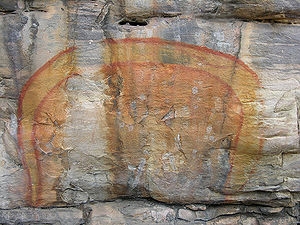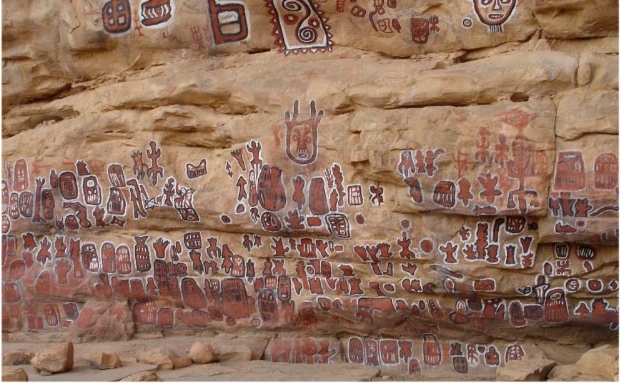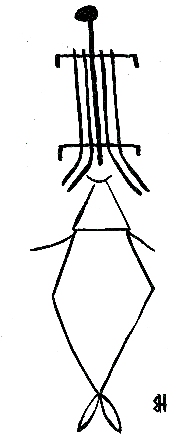Nummo were Rainbow Serpents
Updated June 2023
 Rainbow Serpent, Mark O'Neilwww.DigitalTribes.com http://en.wikipedia.org/wiki/ File:RainbowSerpent.jpg |
The Dogon described the alien Nummo as Rainbow Serpents, which is also a common motif found in the art and mythology of the Indigenous Peoples of Australia. The name "Rainbow Serpent" was coined in 1926 by Professor Alfred Radcliffe-Brown, a British anthropologist specialising in Australian Indigenous ethnology and ethnography.
Radcliffe-Brown determined that many Indigenous peoples shared variations of a common myth telling of an unusually powerful, creative, and often dangerous snake or serpent of enormous size, who was associated with rainbows, rain, rivers, and deep water holes, and who was descended from a larger being visible as a dark streak in the Milky Way. The Australian Rainbow Serpent apparently inhabited permanent water holes and was said to be in control of life's most precious resource, water.Dorey, Day of the Fish, 2017 version p. 344
Water was also the essence of the Nummo and the words "water" and "Nummo" were used interchangeably.Dorey, Day of the Fish, 2017
version p. 345 Water was the symbol for the life-force of the world.Dorey, The Master (Mistress) of Speech, 2018
version p. 8 According to the Dogon, wherever the Nummo landed on the Earth, the water turtle kiru, went around and purified the soil, allowing the rainwater to enter it and stay there to form a pond.Dorey, Day of the Fish, 2017 version p. 345
The Nummos' skin was primarily green, but, like the chameleon, it sometimes changed colours and was said to at times have all the colours of the rainbow.Dorey, The Master (Mistress) of Speech, 2018 version p. 13 In their spaceships, the Nummo were identified with a ram, a rainbow and the sun.
The Dogon elder Ogotemmêli told how the "ram" had the power of movement once it had risen into the heavens. When it moved in the clouds it left a track of four colours that looked like a rainbow. As Griaule reported, "His left forefoot made a black track, his right a red track, the two others one green and one yellow. That fourfold track was called the 'the Nummo's track.'"Dorey, The Master (Mistress) of Speech, 2018 version p. 23
In other descriptions, the spaceship was round like a calabash and glowed in a red ball of light. There was also tubing or piping circulating or curling around the outer top of the craft. This tubing contained either water or "liquid copper" and apparently looked like the horns of a ram, which was why the ships were identified with rams. Since the Nummo also had horns, the spaceships were viewed as being the celestial form of the Nummo.Dorey, The Master (Mistress) of Speech, 2018 version p. 23
Researchers, Dr Paul Tacon and Dr Christopher Chippindale of Cambridge University in Britain, believe the first images of Australian Rainbow Serpents appear in the rock art at the time of the Yam period identified by George Chaloupka, the foremost expert on the rock art of Arnhem Land, beginning around 6000 years ago. These images "set the pattern for all following images: a snake-like body, curved horse-like heads, at least two types of tails (pointed or spiked), and an assortment of plant and animal appendages, including wispy tendrils and ear-like projections."Dorey, Day of the Fish, 2017
version p. 345
Besides a serpent, the Dogon associated the Nummo with a horse. The Dogon word in the Wazouba language for "horse" meant "power."Dorey, Day of the Fish, 2017 version p. 345 "The stacked round wooden cups that the Dogon spiritual leader, the Hogon, used for ceremonies usually had a lid with a horse on top, representing the Nummo.…"Dorey, Day of the Fish, 2017 version p. 80
 An artist's conception of the the Milky Wayhttp://en.wikipedia.org/ wiki/File:236084main_Milk yWay-full-annotated.jpg http://www.spitzer. caltech.edu/Media /releases/ssc2008-10/ssc2008-10b.shtml |
The Rainbow Serpent's connection with the Milky Way may further associate this figure with the alien Nummo, who were also associated with the Milky Way. The Milky Way Galaxy was a symbol of the alien Nummo, who were associated with the divine feminine and perceived as the mothers of all life in the universe. The "star of the Milky Way" was important to the Dogon. Griaule and Dieterlen thought the term might refer to Saturn, because the star of the Milky Way was described as being a bulging funeral urn. The opening of the funeral urn was surrounded by a bulge, which represented the star's permanent halo. I believe the Dogon were actually talking about the Milky Way itself, which is our own galaxy.
Comparing the Milky Way to our observations of another galaxy, scientists have determined what it might look like to an observer from another galaxy. When viewed from the side, a picture of another galaxy shows "the central bulge of the nucleus." There is also a "halo, which is a spherical region, centered on the nucleus, with a radius of about 50,000 light years. This halo contains very old stars, produced early on when the galaxy was still forming. Most of these stars are in vast collections called globular clusters."Dorey, Day of the Fish, 2017 version p. 345
The Dogon drew the picture of the star of the Milky Way under the urn during a consecration of the altar to the ancestors (vageu). All the other deceased members of the lineage were placed in a spiral around it. These ancestors likely symbolized the old stars that were produced when the galaxy was forming. Our galaxy is only one of billions of galaxies in the universe.Dorey, Day of the Fish, 2017 version p. 345
Chaloupka reported that the Australian Rainbow Serpent created human beings.Dorey, Day of the Fish, 2017
version p. 344 According to the Dogon, the Nummo also created humans. It was suggested in Dogon mythology that the Nummos' world was dying, which is why some of them came to Earth. There wasn't any intelligent life on the planet when the Nummo first came here.Dorey, The Master (Mistress) of Speech, 2018 version p. 13
The Nummo were immortal beings and they had the ability to direct their souls on death. The Nummo's plan was to create a new life form here using the animals of Earth so that they could move their souls into those animals and live on the planet. What Dogon mythology tells us is that the experiment failed. Nummo souls were lost to the Earth and humans were born from that failure.Dorey, The Master (Mistress) of Speech, 2018 version p. 13
In the first attempt at biological engineering, the androgynous and immortal aspect of the Nummo did not carry through to both of the offspring. A single-sexed male was born completely severed from the Nummos' spiritual essence and tied to Earth. He was symbolized by the Jackal or fox in the religion. He was born mortal with no knowledge of a previous existence. Ogotemmêli explained how "the original incident was destined to affect the course of things forever."Dorey, The Master (Mistress) of Speech, 2018 version p. 19 From these first offspring, the Dogon perceived the androgynous human/Nummo hybrid as being feminine, immortal and good. The brother of this being was perceived as having been born mortal and soulless. He was the bad element in the religion. "The Jackal was alone from birth," said Ogotemmêli, "and because of this he did more things than can be told."Dorey, The Master (Mistress) of Speech, 2018 version p. 19
Although the Jackal was a single sexed being, the Nummo's androgynous DNA was still part of his genetic makeup. He was perceived as having two souls, one tied to the Nummo and one tied to the Earth. The Nummo believed that the Jackal could only become stable once his Nummo soul and his androgynous nature had been removed. By doing this they were hoping to take him back to some form of his original animal existence so that he could evolve naturally.
In males the Nummo soul was symbolized by the prepuce, which also symbolized the female aspect of his androgynous nature. The prepuce was a womb symbol. The Jackal could only become stable once the second sex and second soul had been removed. The Dogon associated the Jackal's regeneration with the removal of the prepuce through the ritual of circumcision.Dorey, The Master (Mistress) of Speech, 2018 version p. 32
 Dogon Circumcision Cave Paintings by Senani P 2007Creative Commons Attribution ShareAlike 3.0 License. http://en.wikipedia.org /wiki/File: Dogon_Circumsion_Cave_Painting.jpg |
The Dogon elder Ogotemmêli made it very clear to Griaule that after circumcision the second soul was not completely severed but existed as the shadow or the unconscious, which was also shared with the Nummo.Dorey, The Master (Mistress) of Speech, 2018 version p. 19 This was why every human was said to still have two souls. The word "soul" in the Dogon language was kinndou-kinndou, or, "soul-soul".Dorey, The Master (Mistress) of Speech, 2018 version p. 235 The body was one, but the spiritual part of an individual was said to be two. The unconscious or shadow represented the tie humans still had with the Nummo.
I believe the unconscious shared with the Nummo may be associated with the dreamtime talked about by the Indigneous Peoples of Australia. Carl Jung believed that the study of dreams was one way to come to terms with the content of the unconscious and understand truth.
Jung believed that by analysing the images found in their dreams, individuals could get a better understanding of what was happening in their unconscious. Jung thought that the images stored in our unconscious and found in our dreams have been with us since the beginning of time and have similar meanings for all people.Dorey, The Master (Mistress) of Speech, 2018 version p. 9
In the Dogon religion, the removal of the Jackal 's second soul, was linked with the second experiment and the creation of the Master of Speech [Mistress of Speech], a fish tailed being, who represented the perfect combination of Nummo and human. In describing the creation of the Master of Speech [Mistress of Speech] or the regeneration of the Jackal, the Dogon said the Master of Speech [Mistress of Speech], or the Nummo anagonno swallowed the Jackal 's foreskin and became his twin.Dorey, Day of the Fish, 2017 version p. 243
 Jackal's Circumcision ©Robert Hill |
This was symbolically represented by this Dogon diagram, which shows the Jackal being circumcised by the teeth of the Master of Speech [Mistress of Speech].Dorey, Day of the Fish 2017
version p. 243
Australia Indigenous Peoples also tell similar stories relating to circumcision that are likely associated with the story about the Master (Mistress) of Speech circumcising the Jackal with her/his teeth. Joseph Campbell referred to the rite of circumcision among the Murngin tribe:
"Among the aborigines [Indigenous Peoples] of Australia, for example, one of the principal features of the ordeal of initiation (by which the boy at puberty is cut away from the mother and inducted into the society and secret lore of the men) is the rite of circumcision. 'When a little boy of the Murngin tribe is about to be circumcised, he is told by his fathers and by the old men, "The Great Father Snake smells your foreskin; he is calling for it." The boys believe this is to be literally true and become extremely frightened. Usually they take refuge with their mother, mother's mother, or some other favourite female relative; for they know that the men are organized to see that they are taken to the men's ground, where the great snake is bellowing. The women wail over the boys ceremonially; this is to keep the great snake from swallowing them.'"Dorey, Day of the Fish 2017 version p. 346
The statement that "The Great Father Snake smells your foreskin" suggests that the snake is about to eat the boy's foreskin. The women also wail over their sons to keep the snake from swallowing them. We know from Dogon mythology that both circumcision and the swallowing ritual have to do with regeneration.
During the third experiment carried about by the Nummo, the Master (Mistress) of Speech mythically swallows and then regurgitates Lébé. In the Murngin myth, the snake swallows the boy or the boy's foreskin, so the boy can be renewed. The foreskin in the Dogon religion was a symbol of instability and the boy could not become stable until the second sex or second soul had been removed, which is what the foreskin represents. Since the Nummo were identified with both fish and serpents, it is likely that this Murngin tribe ritual is the same ritual performed by the Dogon. It is through Dogon mythology that we can connect these myths.Dorey, Day of the Fish 2017 version p. 346
The following Australian Indigenous Murrinh-patha myth is also reminiscent of the Dogon Religion. It is performed in Murrinh-patha ceremonies to initiate young men into adulthood.
'A woman, Mutjinga (the 'Old Woman'), was in charge of young children, but instead of watching out for them during their parents' absence, she swallowed them and tried to escape as a giant snake. The people followed her, spearing her and removing the undigested children from the body.'Dorey, Day of the Fish 2017 version p. 347 Within the myth and in its performance, young, unadorned children must first be swallowed by an ancestral being (who transforms into a giant snake), then regurgitated before they are able to be accepted as young adults with all the rights and privileges of young adults.Dorey, Day of the Fish 2017 version p. 347
This is similar to the Dogon religion where a boy cannot be given his full title, establish a cult, take the remedies which the healers give against disease, and use amulets, until he has been circumcised.Dorey, Day of the Fish 2017 version p. 347 These associations suggest similar beliefs between the African Dogon people and Australian Indigenous peoples. The Australian Indigenous Murrinh-patha myth also suggests that the old woman or Mutjinga was a shape-shifter. The Nummo were also said to be shape shifters.
For more information on the Dogon religion refer to my books, The Master (Mistress) of Speech, The Nummo, Day of the Fish and The Rose.